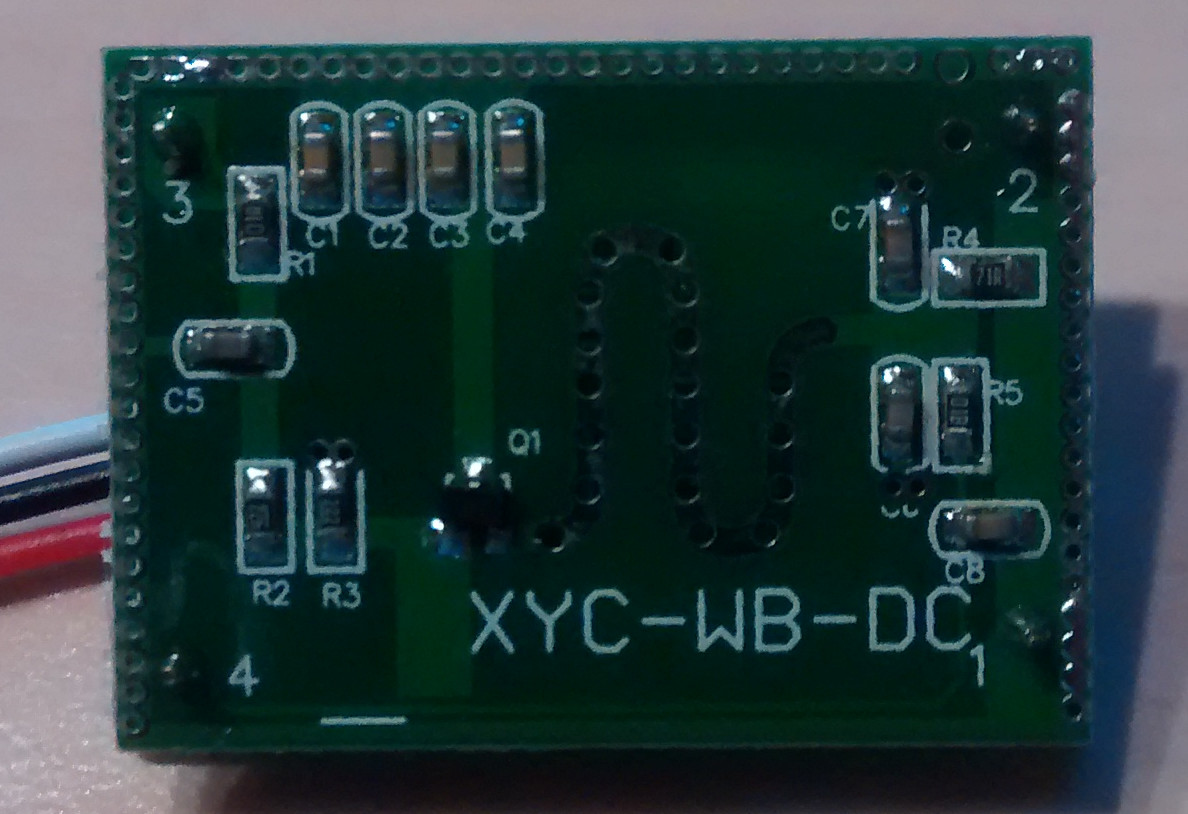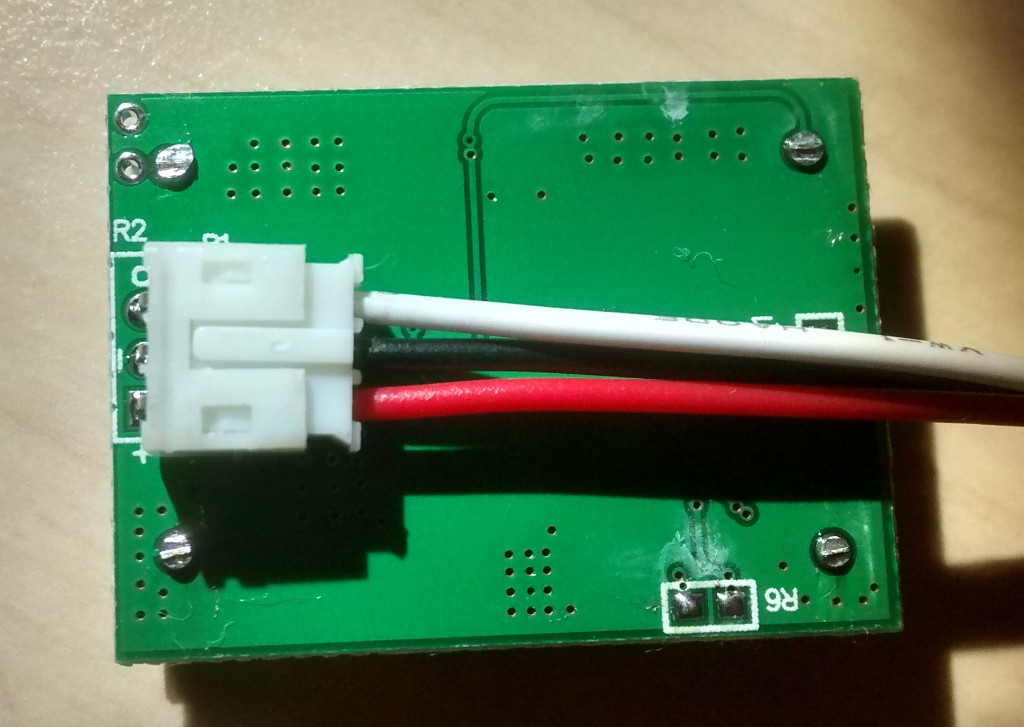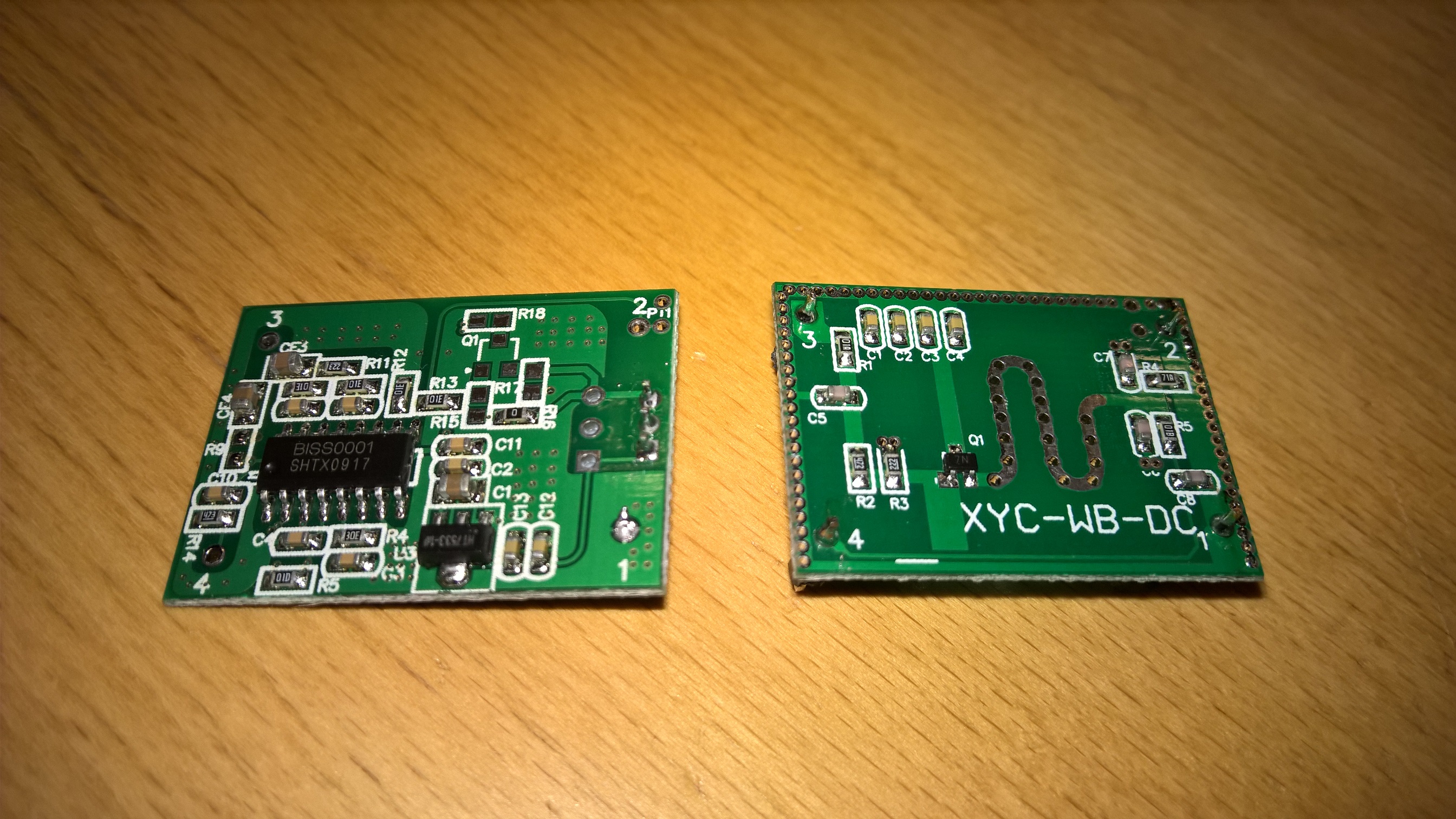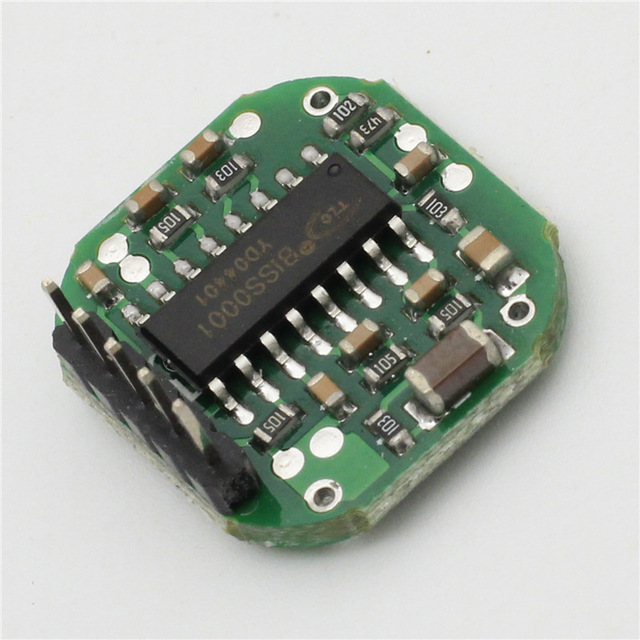Microwave Radar Module as PIR replacement.
-
@Yveaux ahah excellent another module! do you have one of these ?
On all specs they all claims few mA, not sure if it's the best idea on batt..I was thinking to use these things on AC. but that will need tests on power supply.
HB100 I have are shielded..don't know which module is best. I was inspired from this
http://www.limpkin.fr/index.php?post/2013/08/09/Making-the-electronics-for-a-%247-USD-doppler-motion-sensorEdit: the link you pointed, wow the module seems very small!
-
@Yveaux ahah excellent another module! do you have one of these ?
On all specs they all claims few mA, not sure if it's the best idea on batt..I was thinking to use these things on AC. but that will need tests on power supply.
HB100 I have are shielded..don't know which module is best. I was inspired from this
http://www.limpkin.fr/index.php?post/2013/08/09/Making-the-electronics-for-a-%247-USD-doppler-motion-sensorEdit: the link you pointed, wow the module seems very small!
-
Looks like an interesting module. Since these are advertised as working in the 5.8 GHz band, it would be interesting to see exactly where in the band they are and if they cause interference for WiFi channels.
Cheers
Al -
I was inspired by this topic and bought some cheap modules from ebay:
http://www.ebay.com/itm/5-8GHZ-Microwave-Radar-Sensor-6-9M-Smart-Switch-for-Home-Control-/401082379029?hash=item5d625f6b15:g:4BMAAOSwxp9W2SerDoes anyone know how to hook them up? Was anyone able to make them work? The chinese seller is not really helpful in providing some more details.
I really like the idea of having a motion sensor behind a wall (read: out of sight), even if it means powering it from a wall socket. -
@danta lol - I too was inspired by this thread and bought a couple of modules which arrived last week. Mine are identical to those in your first ebay link.
I've not tried to use them yet, but I think you use them identical to a PIR. ie VCC, GND and Signal.
As @Yveaux mentioned... these use the same IC as the PIR's, but these do seem to lack the ability to tune the sensitivity and timeouts like the PIR's have.
So in short... try to use them as you would a PIR.
-
There are units that are fitted into light fittings that are being used as fall detectors; a PIR knows someone is in the room but something measuring the height of the person moving around that suddenly notices an increase in the distance can trigger an alarm. An increase in distance can mean that the person is now on the floor and no longer vertical. Something like this could be used maybe?
-
I have this one, but did not have time to test it yet 2-16M : Gravity: Digital Microwave Sensor (Motion Detection)
http://www.dfrobot.com/index.php?route=product/product&product_id=1403#.VzNKlfndWnk
-
I started playing with the first module listed in my previous post:

The module is really as easy to connect as a normal pir sensor. There are small text on the pcb. The top most connection (indicated with a 'o') is the sensor output (3,3v for a high and 0v for a low). The middle connection is ground and the bottom connection is Vcc (3,3 to 20v according to the ebay listing).

My setup was really simple, just a chinduino powered via usb. The sensor connected to +5v, ground and the output to analog pin A0 (I could have used a digital pin).

The first results are really promising. Some characteristics:
- The sensor is omnidirectional.
- Output is high (3,3V) for 30s when movement is detected
- New movement will restart the 30s timer
- 'low' power consumption. Triggered: 1.5mA; Idle: 1.4mA (measured @5v using a normal multimeter)
- The sensor doesn't react to temperature/light fluctuations (unlike most pir sensors)
Some range tests that triggered the output (note that this is probably not the maximum distance, just the stuff I tested):
- 0-4 meter distance (clear line of sight), moving my arm
- 5-8 meter distance (clear line of sight), walking around
- walking around at 5 meter distance with an indoor brick wall between me and the sensor
Stuff that I still need to test:
- Can the sensitivity be tweaked
- How to change the trigger timer to something else than 30s
- Duration test to see if the module is prone to false positives
-
@danta, this device can detect you when you are in another room ?
@drock1985,
detection delay can be adjusted from 1 second to hundreds of second (two minutes max) by adjusting R6 resistor on the board as explained on this Taobao page (Chinese). By default there’s no resistor and the delay is 30 seconds, and you can adjust the delay by using 1K to 250K resistor. -
@drock1985, Didn't test it yet. I was playing with the other module I bought. Too bad that the other module only seems to work stable from 6V and up (I should have known it, as it was listed on ebay as 7-12v). I was just hoping that it would work at lower voltages. So I will probably stick with the first module for now.
@vil1driver, Yes, detection works through wall and door. I only tested it at a distance of about 5 meter with a brick indoor wall between me and the sensor. I also had to walk around before the sensor picked me up (just lifting my arm wasn't enough).
-
Seems like these modules are using the BISS0001 so it will probably not be possible to run them on a battery node because the BISS has a 3V minimum voltage demand. The current consumption is anyhow also a bit to high for battery application (3mA).

-
Seems like these modules are using the BISS0001 so it will probably not be possible to run them on a battery node because the BISS has a 3V minimum voltage demand. The current consumption is anyhow also a bit to high for battery application (3mA).

I've bought a couple of these and in many ways have been impressed.
My only issue is that I find them far too sensitive (e.g. Detecting movement through wallls)
Has anyone managed to reduce the sensitivity? -
@Luke-Corkill said:
I've bought a couple of these and in many ways have been impressed.
My only issue is that I find them far too sensitive (e.g. Detecting movement through wallls)
Has anyone managed to reduce the sensitivity?To reduce sensitivity workaround - Can you place them high and point them in an angle pointing downwards to ground? will this work?
-
There has been some chat about these modules over on Pete Scargill's site.
Seems that using some aluminium foil you can create a shield so there are at least directional.Here is the thread ( starting at the relevant comment)
http://tech.scargill.net/microwave-radar/#comment-16685
I have not tested this myself yet...
-
There has been some chat about these modules over on Pete Scargill's site.
Seems that using some aluminium foil you can create a shield so there are at least directional.Here is the thread ( starting at the relevant comment)
http://tech.scargill.net/microwave-radar/#comment-16685
I have not tested this myself yet...
@gregl
Thanks for good link :-)
Yes offcurse I'm so sloooooow we need a proper waveguide or a hornet antenna, so ensure correct directionality ;-)This might not be needed, but a hint what could be done: http://hforsten.com/horn-antenna-for-radar.html
When my doppler radar arrives I will make a trial with a small tinbox I don't know about using alufoil is good for a long periode used outside
http://hackaday.com/2014/02/24/guest-post-try-radar-for-your-next-project/#jp-carousel-115578 -
@Yveaux I did some extensive testing on the FC1816 module and I thought I might drop my experience:
http://electronics.stackexchange.com/questions/226031/pinout-of-microwave-motion-sensor-fc1816
In the end I used an 150ohm Series resistor + ~100µF cap behind this to power the FC1816. This eliminated much of the leftover noise. If this is not enough I presented a way to lower the module amplification. In the end I deactivated the biss-trigger output alltogether and grabbed the raw signal. Doing some manual processing:
- take 100 reads
- get the stddev (statistics library)
- high stddev = high fluctuation in values = movement
Take a look at my current working copy of my code for the FC1816:
Some notes:
I power the VCC of the FC1816 from some arduino pins. Thus I can deactivate the microwave sensor at will. This is still not recommended. If you visit the previous link you can see that the BISS has some kind of "warmup"-Period.
I use 3,3Volt to power the NRF24, the arduino and the FC1816 and suffered no strange consequences so far.
Get get some insight about the link quality of the NRF24 I made the function RF24_getObserverTX() accessible from user-space:
MySensors\drivers\RF24\RF24.cpp
uint8_t RF24_getObserveTX(void) { return RF24_readByteRegister(OBSERVE_TX); }MySensors\drivers\RF24\RF24.h
uint8_t RF24_getObserveTX(void);The Idea behind the OBSERVE_TX register is that the lower byte presents the number of retrys the NRF24 used in the last send.
The upper 4 bits present the number of total failed packets. I suggest using (0x0F & RF24_getObserveTX()) to get a usable number 0-15 presenting the retry-count. Anything > 0 suggests a packetloss on your link. 15 most likely will mean you ran into an complete fail as the max number of retrys was exhausted.This number might be capped by
// ARD, auto retry count #define RF24_ARC 15from the RF24.h driver-file.
TO not run into compiling errors you might need:
http://arduiniana.org/libraries/streaming/
https://github.com/RobTillaart/Arduino/tree/master/libraries/StatisticMicrowaveRadarSensor.ino
#include <Streaming.h> #include "Statistic.h" /** * The MySensors Arduino library handles the wireless radio link and protocol * between your home built sensors/actuators and HA controller of choice. * The sensors forms a self healing radio network with optional repeaters. Each * repeater and gateway builds a routing tables in EEPROM which keeps track of the * network topology allowing messages to be routed to nodes. * * Created by Henrik Ekblad <henrik.ekblad@mysensors.org> * Copyright (C) 2013-2015 Sensnology AB * Full contributor list: https://github.com/mysensors/Arduino/graphs/contributors * * Documentation: http://www.mysensors.org * Support Forum: http://forum.mysensors.org * * This program is free software; you can redistribute it and/or * modify it under the terms of the GNU General Public License * version 2 as published by the Free Software Foundation. * ******************************* * * REVISION HISTORY * Version 1.0 - Henrik EKblad * * DESCRIPTION * Example sketch showing how to measue light level using a LM393 photo-resistor * http://www.mysensors.org/build/light */ #define MY_NODE_ID 10 #define MY_BAUD_RATE 57600 // Enable debug prints to serial monitor //#define MY_DEBUG // Enable and select radio type attached #define MY_RADIO_NRF24 //#define MY_RADIO_RFM69 #include <SPI.h> #include <MySensors.h> #define LIGHT_SENSOR_ANALOG_PIN A3 #define MICRO_SENSOR_ANALOG_PIN A1 unsigned long SLEEP_TIME = 1000; // Sleep time between reads (in milliseconds) #define CHILD_ID_LIGHT 0 #define CHILD_ID_MICRO 0 #define TRIPPED_THRESHOLD 50 MyMessage msg_light(CHILD_ID_LIGHT, V_LIGHT_LEVEL); // 23 MyMessage msg_micro(CHILD_ID_MICRO, V_TRIPPED); // 16 MyMessage msg_micro_debug(0,V_VAR1); // 24 MyMessage msg_obstx_debug(0,V_VAR2); // 25 void before() { // LightSensor pinMode(A3,INPUT_PULLUP); pinMode(A2,OUTPUT); digitalWrite(A2,LOW); // Microwave pinMode(5,OUTPUT); // VCC BISS0001 digitalWrite(5,HIGH); pinMode(6,OUTPUT); // Enabled digitalWrite(6,LOW); // Enable pinMode(7,OUTPUT); // GND digitalWrite(7,LOW); pinMode(8,OUTPUT); // VCC Radar digitalWrite(8,HIGH); pinMode(A1,INPUT); // PIR 2nd Amplification Stage // Other } void setup() { } void presentation() { // Send the sketch version information to the gateway and Controller sendSketchInfo("Microwave+Light", "1.0"); // Register all sensors to gateway (they will be created as child devices) // https://www.mysensors.org/download/serial_api_20#sensor-type present(CHILD_ID_LIGHT, S_LIGHT_LEVEL); present(CHILD_ID_MICRO, S_MOTION); //present(0, S_ARDUINO_NODE); } void loop() { // Report VCC static long vcc = readVcc(); static int vccpercent = map(vcc,1800,3280,0,100); sendBatteryLevel(max(min(vccpercent,100),0),false); Serial << "| vcc: "; p(F("%4d"),vcc); Serial << " "; // Required for ack //wait(100); // Report LightLevel analogRead(LIGHT_SENSOR_ANALOG_PIN); int lightLevel_raw = analogRead(LIGHT_SENSOR_ANALOG_PIN); int lightLevel = (1023-lightLevel_raw)/10.23; // as of 1023 !! Serial << "| light_raw: "; p(F("%4d"),lightLevel_raw); Serial << " "; Serial << "| light: "; p(F("%3d"),lightLevel); Serial << " "; send(msg_light.set(lightLevel),false); // Report WirelessLink Information Serial << "| observe_tx: "; uint8_t obstx = RF24_getObserveTX(); p(F("%X"),obstx); Serial << " "; send(msg_obstx_debug.set(0x0F&obstx),false); // Report Microwave Statistic mw_s; mw_s.clear(); delay(90); analogRead(MICRO_SENSOR_ANALOG_PIN); delay(10); for(int i = 0; i < 1000; i++) { mw_s.add(analogRead(MICRO_SENSOR_ANALOG_PIN)); delay(1); } Serial << "| mw_raw: "; int stddev = mw_s.pop_stdev(); p(F("%4d"),stddev); Serial << " "; Serial << "| mw_min: "; int minimum = mw_s.minimum(); p(F("%4d"),minimum); Serial << " "; Serial << "| mw_max: "; int maximum = mw_s.maximum(); p(F("%4d"),maximum); Serial << " "; Serial << "| mw: " << (stddev > TRIPPED_THRESHOLD ? "1" : "0") << " "; send(msg_micro_debug.set(stddev),false); while(!send(msg_micro.set(stddev > TRIPPED_THRESHOLD ? "1" : "0"),true)) { wait(10); } if(isTransportOK()) wait(100); else wait(1000); Serial << endl; //mysleep(500); } // https://forum.mysensors.org/topic/3463/m_ack_variable-or-m_set_variable/2 void receive(const MyMessage &message) { if (message.isAck()) { Serial.print("| GW ack"); } }Helper.ino
long readVcc() { // Read 1.1V reference against AVcc // set the reference to Vcc and the measurement to the internal 1.1V reference #if defined(__AVR_ATmega32U4__) || defined(__AVR_ATmega1280__) || defined(__AVR_ATmega2560__) ADMUX = _BV(REFS0) | _BV(MUX4) | _BV(MUX3) | _BV(MUX2) | _BV(MUX1); #elif defined (__AVR_ATtiny24__) || defined(__AVR_ATtiny44__) || defined(__AVR_ATtiny84__) ADMUX = _BV(MUX5) | _BV(MUX0); #elif defined (__AVR_ATtiny25__) || defined(__AVR_ATtiny45__) || defined(__AVR_ATtiny85__) ADMUX = _BV(MUX3) | _BV(MUX2); #else ADMUX = _BV(REFS0) | _BV(MUX3) | _BV(MUX2) | _BV(MUX1); #endif delay(2); // Wait for Vref to settle ADCSRA |= _BV(ADSC); // Start conversion while (bit_is_set(ADCSRA,ADSC)); // measuring uint8_t low = ADCL; // must read ADCL first - it then locks ADCH uint8_t high = ADCH; // unlocks both long result = (high<<8) | low; result = 1125300L / result; // Calculate Vcc (in mV); 1125300 = 1.1*1023*1000 //result *= 1.0637; return result; // Vcc in millivolts } #include <stdarg.h> void p(const __FlashStringHelper *fmt, ... ){ char buf[128]; // resulting string limited to 128 chars va_list args; va_start (args, fmt); #ifdef __AVR__ vsnprintf_P(buf, sizeof(buf), (const char *)fmt, args); // progmem for AVR #else vsnprintf(buf, sizeof(buf), (const char *)fmt, args); // for the rest of the world #endif va_end(args); Serial.print(buf); } void mysleep(int SLEEP_TIME) { if(isTransportOK()){ Serial << "| wait "; wait(25); Serial << "| zZz > "; sleep(SLEEP_TIME); Serial << "| < zZz " << endl; } else { wait(1000); } } -
@Yveaux I did some extensive testing on the FC1816 module and I thought I might drop my experience:
http://electronics.stackexchange.com/questions/226031/pinout-of-microwave-motion-sensor-fc1816
In the end I used an 150ohm Series resistor + ~100µF cap behind this to power the FC1816. This eliminated much of the leftover noise. If this is not enough I presented a way to lower the module amplification. In the end I deactivated the biss-trigger output alltogether and grabbed the raw signal. Doing some manual processing:
- take 100 reads
- get the stddev (statistics library)
- high stddev = high fluctuation in values = movement
Take a look at my current working copy of my code for the FC1816:
Some notes:
I power the VCC of the FC1816 from some arduino pins. Thus I can deactivate the microwave sensor at will. This is still not recommended. If you visit the previous link you can see that the BISS has some kind of "warmup"-Period.
I use 3,3Volt to power the NRF24, the arduino and the FC1816 and suffered no strange consequences so far.
Get get some insight about the link quality of the NRF24 I made the function RF24_getObserverTX() accessible from user-space:
MySensors\drivers\RF24\RF24.cpp
uint8_t RF24_getObserveTX(void) { return RF24_readByteRegister(OBSERVE_TX); }MySensors\drivers\RF24\RF24.h
uint8_t RF24_getObserveTX(void);The Idea behind the OBSERVE_TX register is that the lower byte presents the number of retrys the NRF24 used in the last send.
The upper 4 bits present the number of total failed packets. I suggest using (0x0F & RF24_getObserveTX()) to get a usable number 0-15 presenting the retry-count. Anything > 0 suggests a packetloss on your link. 15 most likely will mean you ran into an complete fail as the max number of retrys was exhausted.This number might be capped by
// ARD, auto retry count #define RF24_ARC 15from the RF24.h driver-file.
TO not run into compiling errors you might need:
http://arduiniana.org/libraries/streaming/
https://github.com/RobTillaart/Arduino/tree/master/libraries/StatisticMicrowaveRadarSensor.ino
#include <Streaming.h> #include "Statistic.h" /** * The MySensors Arduino library handles the wireless radio link and protocol * between your home built sensors/actuators and HA controller of choice. * The sensors forms a self healing radio network with optional repeaters. Each * repeater and gateway builds a routing tables in EEPROM which keeps track of the * network topology allowing messages to be routed to nodes. * * Created by Henrik Ekblad <henrik.ekblad@mysensors.org> * Copyright (C) 2013-2015 Sensnology AB * Full contributor list: https://github.com/mysensors/Arduino/graphs/contributors * * Documentation: http://www.mysensors.org * Support Forum: http://forum.mysensors.org * * This program is free software; you can redistribute it and/or * modify it under the terms of the GNU General Public License * version 2 as published by the Free Software Foundation. * ******************************* * * REVISION HISTORY * Version 1.0 - Henrik EKblad * * DESCRIPTION * Example sketch showing how to measue light level using a LM393 photo-resistor * http://www.mysensors.org/build/light */ #define MY_NODE_ID 10 #define MY_BAUD_RATE 57600 // Enable debug prints to serial monitor //#define MY_DEBUG // Enable and select radio type attached #define MY_RADIO_NRF24 //#define MY_RADIO_RFM69 #include <SPI.h> #include <MySensors.h> #define LIGHT_SENSOR_ANALOG_PIN A3 #define MICRO_SENSOR_ANALOG_PIN A1 unsigned long SLEEP_TIME = 1000; // Sleep time between reads (in milliseconds) #define CHILD_ID_LIGHT 0 #define CHILD_ID_MICRO 0 #define TRIPPED_THRESHOLD 50 MyMessage msg_light(CHILD_ID_LIGHT, V_LIGHT_LEVEL); // 23 MyMessage msg_micro(CHILD_ID_MICRO, V_TRIPPED); // 16 MyMessage msg_micro_debug(0,V_VAR1); // 24 MyMessage msg_obstx_debug(0,V_VAR2); // 25 void before() { // LightSensor pinMode(A3,INPUT_PULLUP); pinMode(A2,OUTPUT); digitalWrite(A2,LOW); // Microwave pinMode(5,OUTPUT); // VCC BISS0001 digitalWrite(5,HIGH); pinMode(6,OUTPUT); // Enabled digitalWrite(6,LOW); // Enable pinMode(7,OUTPUT); // GND digitalWrite(7,LOW); pinMode(8,OUTPUT); // VCC Radar digitalWrite(8,HIGH); pinMode(A1,INPUT); // PIR 2nd Amplification Stage // Other } void setup() { } void presentation() { // Send the sketch version information to the gateway and Controller sendSketchInfo("Microwave+Light", "1.0"); // Register all sensors to gateway (they will be created as child devices) // https://www.mysensors.org/download/serial_api_20#sensor-type present(CHILD_ID_LIGHT, S_LIGHT_LEVEL); present(CHILD_ID_MICRO, S_MOTION); //present(0, S_ARDUINO_NODE); } void loop() { // Report VCC static long vcc = readVcc(); static int vccpercent = map(vcc,1800,3280,0,100); sendBatteryLevel(max(min(vccpercent,100),0),false); Serial << "| vcc: "; p(F("%4d"),vcc); Serial << " "; // Required for ack //wait(100); // Report LightLevel analogRead(LIGHT_SENSOR_ANALOG_PIN); int lightLevel_raw = analogRead(LIGHT_SENSOR_ANALOG_PIN); int lightLevel = (1023-lightLevel_raw)/10.23; // as of 1023 !! Serial << "| light_raw: "; p(F("%4d"),lightLevel_raw); Serial << " "; Serial << "| light: "; p(F("%3d"),lightLevel); Serial << " "; send(msg_light.set(lightLevel),false); // Report WirelessLink Information Serial << "| observe_tx: "; uint8_t obstx = RF24_getObserveTX(); p(F("%X"),obstx); Serial << " "; send(msg_obstx_debug.set(0x0F&obstx),false); // Report Microwave Statistic mw_s; mw_s.clear(); delay(90); analogRead(MICRO_SENSOR_ANALOG_PIN); delay(10); for(int i = 0; i < 1000; i++) { mw_s.add(analogRead(MICRO_SENSOR_ANALOG_PIN)); delay(1); } Serial << "| mw_raw: "; int stddev = mw_s.pop_stdev(); p(F("%4d"),stddev); Serial << " "; Serial << "| mw_min: "; int minimum = mw_s.minimum(); p(F("%4d"),minimum); Serial << " "; Serial << "| mw_max: "; int maximum = mw_s.maximum(); p(F("%4d"),maximum); Serial << " "; Serial << "| mw: " << (stddev > TRIPPED_THRESHOLD ? "1" : "0") << " "; send(msg_micro_debug.set(stddev),false); while(!send(msg_micro.set(stddev > TRIPPED_THRESHOLD ? "1" : "0"),true)) { wait(10); } if(isTransportOK()) wait(100); else wait(1000); Serial << endl; //mysleep(500); } // https://forum.mysensors.org/topic/3463/m_ack_variable-or-m_set_variable/2 void receive(const MyMessage &message) { if (message.isAck()) { Serial.print("| GW ack"); } }Helper.ino
long readVcc() { // Read 1.1V reference against AVcc // set the reference to Vcc and the measurement to the internal 1.1V reference #if defined(__AVR_ATmega32U4__) || defined(__AVR_ATmega1280__) || defined(__AVR_ATmega2560__) ADMUX = _BV(REFS0) | _BV(MUX4) | _BV(MUX3) | _BV(MUX2) | _BV(MUX1); #elif defined (__AVR_ATtiny24__) || defined(__AVR_ATtiny44__) || defined(__AVR_ATtiny84__) ADMUX = _BV(MUX5) | _BV(MUX0); #elif defined (__AVR_ATtiny25__) || defined(__AVR_ATtiny45__) || defined(__AVR_ATtiny85__) ADMUX = _BV(MUX3) | _BV(MUX2); #else ADMUX = _BV(REFS0) | _BV(MUX3) | _BV(MUX2) | _BV(MUX1); #endif delay(2); // Wait for Vref to settle ADCSRA |= _BV(ADSC); // Start conversion while (bit_is_set(ADCSRA,ADSC)); // measuring uint8_t low = ADCL; // must read ADCL first - it then locks ADCH uint8_t high = ADCH; // unlocks both long result = (high<<8) | low; result = 1125300L / result; // Calculate Vcc (in mV); 1125300 = 1.1*1023*1000 //result *= 1.0637; return result; // Vcc in millivolts } #include <stdarg.h> void p(const __FlashStringHelper *fmt, ... ){ char buf[128]; // resulting string limited to 128 chars va_list args; va_start (args, fmt); #ifdef __AVR__ vsnprintf_P(buf, sizeof(buf), (const char *)fmt, args); // progmem for AVR #else vsnprintf(buf, sizeof(buf), (const char *)fmt, args); // for the rest of the world #endif va_end(args); Serial.print(buf); } void mysleep(int SLEEP_TIME) { if(isTransportOK()){ Serial << "| wait "; wait(25); Serial << "| zZz > "; sleep(SLEEP_TIME); Serial << "| < zZz " << endl; } else { wait(1000); } }@cimba007 wow, you did some serious research there! (I see you make good use of the arduino plot function)
I'll certainly come back to your research once I start with this sensor (so much to choose from...)
Any ideas about current consumption? Is this a viable alternative to battery powered pir sensors?


